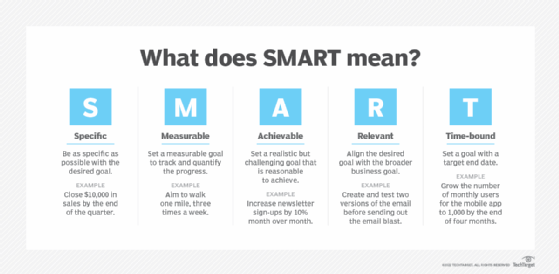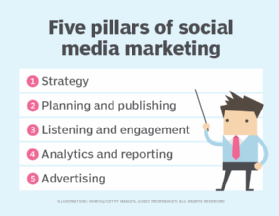What are social media metrics?
Social media metrics are the various data points that can help a company gauge the impact of social media activity on its revenue. These metrics are used to measure the performance of social media marketing campaigns and to assess how well these campaigns accomplish the company's goals.
All social media management campaigns occur with goals in mind. The most common goals are the following:
- Increase engagement when users interact with content on platforms.
- Gather feedback from the target audience about the company or its offerings.
- Generate more leads.
- Support other direct sales initiatives to increase conversion rates.
- Boost sales and revenue.
- Provide customer support and enhance customer experiences.
- Demonstrate the company's thought leadership in its chosen niche or industry.
- Increase brand mentions, brand recognition, awareness and relevance with the target audience.
To achieve these, organizations must set SMART goals (specific, measurable, achievable, realistic, time-bound). The M is where social media metrics apply. The figure below presents the SMART approach.

The right set of social media engagement metrics can help the organization assess social media marketing campaign performance and determine if it can meet its goals. Social media metrics determine the effectiveness of a social media marketing strategy in achieving its goal and adding value to the business (e.g., delivering a social media return on investment, i.e., ROI). Metrics also provide tangible insights into campaign gaps and where changes might help move results closer to the stated goal(s). They provide benchmarks for evaluating performance, audience demographics, content strategy and customer satisfaction.
Common social media metrics
It is often debated which social media metrics are most useful for measuring campaign performance. Some marketers prefer to capture traditional user engagement metrics like clickthrough rates, time on page and content shares. Other marketers use content analytics and search-based applications to track whether audience sentiment is positive or negative.

Other widely used social media metrics include the following:
- Comments (on the post): how many users commented on a post or ad.
- Retweets: how many times a company's tweet is retweeted.
- Impressions: the number of people who saw a piece of social media content (e.g., a post).
- Account (@) mentions: the number of organic (unpaid) mentions (an indicator of good brand awareness).
- Number of impressions posted: the number of times a post shows up in someone's timeline.
- Post reach: the potential unique viewers of a single post.
- Post engagement rate: the number of post engagements divided by impressions or reach.
- Audience growth rate: the speed at which the number of brand followers grows.
- Share of voice: the volume of online discussion occurring around a certain keyword and brand.
Some additional popular social media metrics include bounce rate (the percentage of users who visit a website page and leave without clicking on any other pages), cost-per-click (the cost to a company every time its ad is clicked), response rate (the percentage of the audience the brand is responding to on social media), response time (the time it takes for a brand to respond to the audience), and conversions (the number of people who made a transaction after visiting a brand's social media channel).
Benefits of social media metrics
Metrics help assess how close the company is to achieving its social media goals. Regardless of which metric marketers examine, metrics data lets them document the payoff on their social media marketing investment.
Social media metrics and their associated reports help reveal the ROI from social media, which can guide decisions on whether to increase, decrease or keep intact specific campaign investments. If the ROI is high, it can positively impact both the social media budget and its future direction, which can then impact the brand's social media visibility and awareness, and revenue and profits from social media.
It's important for brands to identify the right metrics among the many. Brands that focus on the most important metrics are better able to set clear, measurable goals and track progress toward achieving them. Those that measure any and all metrics usually fail to understand the big picture of social media performance and ROI.
Limitations of social media metrics
Choosing the wrong metrics can create problems such as quality of data. Data can be biased or limited in its demographic reach. Difficulties measuring audience data might arise, but the use of analytics tools can help address this. Choosing the wrong social media influencer and using the wrong social media analytics tools may result in undesirable results. Costs associated with analyzing social medi
Social media monitoring software
As more users get on social media, the nature of social conversations, particularly between users (customers) and brands, tends to get more dispersed and diverse. As a result, marketers find it challenging to aggregate multiple social conversations and consolidate them to create a single, meaningful and insightful view of campaign performance and progress.
They also struggle to make the data meaningful and digestible to business-line executives and find it hard to deal with newer and more stringent privacy settings on social media websites. These settings create roadblocks that make it more difficult for companies to gather useful social media data.
To get around these challenges, marketers often use social media monitoring software to observe activity on social platforms and gather information about how a target audience perceives a brand, product or company-related topic. These tools provide visual dashboards and reports that simplify many campaign-related tasks, including campaign performance measurement. Advances in data visualization, big data analytics and predictive modeling make it even easier for marketers to turn data into actionable items that help companies maximize their social media investments.
Here's a brief list of social media monitoring tools:
- Agorapulse.
- Brand24
- Brandwatch
- BuzzSumo
- Cyfe
- Onclusive Social (formerly Digimind)
- Google Analytics
- Hootsuite
- Keyhole
- Meltwater
- Semrush Social
- Sendible
- SparkToro
- Sprout Social
- Statusbrew
- Synthesio
- Talkwalker
- TweetDeck
When evaluating a social media analytics tool, check to see which platforms (e.g., Facebook, Instagram, X, YouTube) and metrics it supports. Look for visual dashboards that display results, and review reports the system generates. Artificial intelligence (AI) capabilities are an important plus.
KPIs for social media
Social media key performance indicators (KPIs) help direct an organization's social media marketing strategy and program(s) and illuminate how well the strategy is working. Here are some social media KPIs:
- Levels of customer engagement. This measure provides data on how much customers interact with social media content, e.g., likes, comments and shares.
- Content impressions. This example of content analytics looks at the frequency content is displayed, regardless of what happens.
- Increase in follower numbers. This presents data on how the number of followers is changing over time.
- Click-Through Rate (CTR). This metric identifies the number of viewers who clicked on a link in a post out of the total number who viewed it.
- Frequency of conversion. This is the percentage of visitors to a site who initiate a response like making a purchase.
- Inquiries by customers. This is how many questions or comments come from users seeking information or support.
- Website traffic. This is how much traffic goes to a specific website from various social media platforms.
These and other KPIs provide insights into the effectiveness of social media strategies and programs and are key inputs for decision-making to improve performance.
Artificial intelligence and the future of social media metrics
With a sea of data to be processed, AI is an ideal tool to enhance metrics data analysis and provide actionable recommendations. Given the ubiquity and importance of social media in today's lifestyles and business activities, the future of social media metrics and their analysis is strong and likely to grow significantly in the coming years.
Learn about the history and evolution of social media. Understand the elements of an executive social strategy and how it can enhance a company's reputation while attracting new audiences. Explore best practices for harnessing social media analytics data and see why is social media important for e-commerce.





